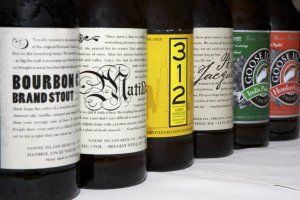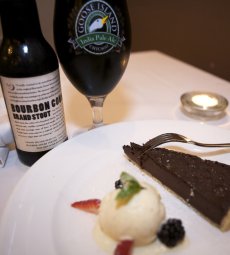 |

|
|

|
|
|
 |

home
about
features
A-Z
books

|

|

features
|

| |
Cooking the Goose
by Willard Clarke, 09/08
The goose was well and truly cooked at the celebrated White Horse in Parson's Green, south London, on 12 September when beers
from the Goose Island brewery in Chicago were on display. Hosted by brewmaster Greg Hall (below), the evening was built round a sumptuous
six-course dinner, with each course matched by a Goose Island beer.
| British drinkers have been able to enjoy the brewery's IPA and Honkers Ale for several years but a clutch of beers new to Britain were on
display and will be available via the James Clay import company in due course.
The evening kicked off with Yorkshire Puddings topped with rare roast beef and hot horseradish backed by Goose Island IPA (5.9%). The
beer is generously hopped with American Cascade and Mount Hood varieties, along with Czech Saaz and Styrian Goldings: the hops
create a redoubtable 58 units of bitterness and beautifully cut the hot and spicy flavours of the puddings.
|
|
 |

|
|
We ate the puddings standing so the guests could mingle and chat with representatives of the brewery, who had managed to pack in a
visit to Harvey's brewery in Lewes, Sussex, before coming on to London. Seated at table, we were presented with a Mussel Bree of fresh
English mussels in white wine and cream soup accompanied by a 7% Matilda ale. Greg and his team often visit Belgium and Matilda is
inspired by the Trappist beer Orval. Matilda is a reference to the Duchess of Tuscany who lost her ring in a well in the grounds of the
abbey. The ring was returned to her by a trout, which gave rise to the abbey's logo of a trout with a ring in its mouth.
In common with
Orval, Matilda is a pale gold beer that uses Brettanomyces yeast for a secondary fermentation in bottle. "Brett" is the wild yeast strain
used in the Brussels area to ferment lambic and gueuze beers and it gives the familiar "horse blanket" aroma to Matilda, balanced by
tangy hop resins from Saaz and Styrians.
|
The bittersweet palate has juicy malt, sour apple fruit and hop resins, with a good balance
of fruit and hops in the finish. The beer's flavours were a fine accompaniment to the salty and rich mussels and cream.
A palate-cleansing sorbet was joined by Urban Wheat (4.4%) , which Greg Hall described as an English summer beer in style. It's
brewed with pale malt and torrefied wheat and is hopped with Cascade. It's very pale in colour and has a protein haze from the wheat.
The sorbet, dominated by pears, was well balanced by the creamy malt and fruity hop character of the beer. Citrus fruit from the
Cascades burst through on the palate and challenged the more subtle pear notes of the sorbet.
|
|

|
The main course of the evening was roast stuffed goose and seasonal vegetables with walk-on parts for duck, chicken, partridge
and guinea fowl. It was joined at table by Honkers Ale (4.3%) with its familiar rich biscuity malt and hop resins on the nose. The beer
is brewed with pale and crystal malts and Styrian Goldings (35 bitterness units). The main course had massive and complex flavours
but Honkers, with juicy malt, tangy hops and citrus fruit in the mouth and finish, stood up to the job and provided a fine and quenching
balance.

|
|
For many present, the stand-out beer of the evening was Bourbon County Stout. This remarkable beer is 13% and was first brewed in
1992 to celebrate Goose Island's 1,000th batch of beer. 2,600 pounds of malt are used to create the stout's great strength. It has 10
days fermentation and is then aged in whisky barrels obtained from the Bourbon industry. The barrels, transported the long distance
from Kentucky to Chicago, are between 17 and 21 years old. The beer stays in the barrels for six months. It's brewed with pale,
Munich, caramalt, black and chocolate malts and is hopped with English Fuggles. It has 55 bitterness units. Ageing gives it vanilla
and tannic notes that balance the rich coffee and chocolate character of the malts. The stout accompanied a full-flavoured Chocolate
and Vanilla Torte.
|
Finally, a British cheese board with Keen's Cheddar, Colston Bassett Blue Stilton and Stinking Bishop was joined a 9% P�re Jacques,
named in honour of the abbot at the Rochefort Trappist monastery and brewery in Belgium. It's brewed with pale, caramalt, Munich
and chocolate malts and hopped with Czech Saaz. A Belgian yeast culture is used for fermentation. The beer was served in a
Cognac-shaped glass and has a red/bronze colour. It has a pears and vanilla pods aroma with strong hints of sultana fruit. Pears
dominate the palate with many other overlapping fruits - cherries and sultanas to the fore. It has a deep and long bittersweet finish
with tangy hop resins. Beer and powerful cheeses proved a marriage made in heaven and the perfect end to a memorable evening.
*Beer-pages will report when the new Goose Island beers are available in Britain.
|
|
home
about
features
A-Z
books
|

